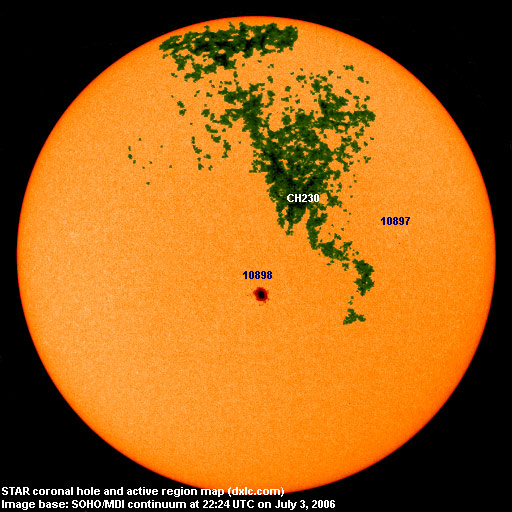

Last major update issued on July 4, 2006 at 04:20 UTC.
[Solar and
geomagnetic data - last month (updated daily)]
[Solar wind and
electron fluence charts (updated daily)]
[Solar cycles 21-23
(last update June 7, 2006)]
[Solar cycles 1-20]
[Graphical comparison
of cycles 21, 22 and 23 (last update June 7, 2006)]
[Graphical
comparison of cycles 2, 10, 13, 17, 20 and 23 (last update June 7, 2006)]
[Historical solar and
geomagnetic data charts 1954-2005 (last update March 3, 2006)]
[Archived reports (last update
June 5, 2006)]
The geomagnetic field was inactive to quiet on July 3. Solar wind speed ranged between 275 and 348 km/s (all day average 300 km/s - decreasing 61 km/s from the previous day).
Solar flux measured at 20h UTC on 2.8 GHz was 85.9. The planetary A index
was 4 (STAR Ap - based on the mean of three hour interval ap
indices: 3.8).
Three hour interval K indices: 10110212 (planetary), 00121002 (Boulder).
The background x-ray flux is at the class B1 level.
At midnight there were 2 spotted regions on the visible solar disk. The solar flare activity level was low. A single C class event was recorded during the day.
Region 10897 decayed slowly and could become spotless today.
Region 10898 has patches of positive polarity surrounding the large
negative polarity spot. C flares are possible. Flare:
C1.2 long duration event peaking at 23:04 UTC.
July 1-3: No partly or fully Earth directed CMEs were detected in incomplete LASCO imagery.
Coronal hole history (since late October 2002)
Compare today's report to the situation one solar rotation ago:
28 days ago
27 days ago
26 days ago
A recurrent trans equatorial coronal hole (CH230) was in an Earth facing position on July 1-3.

Processed SOHO/EIT 284 image at 01:06 UTC on July 4. The darkest areas on the solar disk are likely coronal holes.
The geomagnetic field is expected to be to range from quiet to minor storm July 4-6 due to a high speed stream from CH230. Mostly quiet is likely on July 7-8
| Coronal holes (1) | Coronal mass ejections (2) | M and X class flares (3) |
1) Effects from a coronal hole could reach Earth
within the next 5 days. When the high speed stream has arrived the color changes to green.
2) Effects from a CME are likely to be observed at Earth within 96 hours.
3) There is a possibility of either M or X class flares within the next 48 hours.
Green: 0-20% probability, Yellow: 20-60% probability, Red: 60-100% probability.
Long distance low and medium frequency (below 2 MHz) propagation along east-west paths over high and upper middle latitudes is poor. Propagation on long distance northeast-southwest paths is poor. Trans Atlantic propagation conditions are normally monitored every night on 1470 kHz. Radio Cristal del Uruguay had a weak to occasionally fair signal. While propagation was generally poor, the best reception was noted from stations along the east coast of the Buenos Aires province. Both 1030 Radio del Plata and 1270 Radio Provincia had strong signals while a more interesting unidentified station from Argentina was noted on 1400 kHz.

Compare to the previous day's image.
Data for all numbered solar regions according to the Solar Region Summary provided by NOAA/SEC. Comments are my own, as is the STAR spot count (spots observed at or inside a few hours before midnight) and data for regions not numbered by SEC or where SEC has observed no spots. SEC active region numbers in the table below and in the active region map above are the historic SEC/USAF numbers.
| Active region | Date numbered | SEC spot count |
STAR spot count |
Location at midnight | Area | Classification | Comment |
|---|---|---|---|---|---|---|---|
| 10897 | 2006.06.25 | 4 | 2 | N07W37 | 0020 | CSO | classification was BXO at midnight, area 0000 |
| 10898 | 2006.06.28 | 14 | 8 | S07W01 | 0360 | DKI | classification was CKO at midnight |
| S666 | 2006.06.28 | N05W43 | plage | ||||
| Total spot count: | 18 | 10 | |||||
| SSN: | 38 | 30 | |||||
| Month | Average solar flux at Earth |
International sunspot number | Smoothed sunspot number |
|---|---|---|---|
| 2000.04 | 184.2 | 125.5 | 120.8 cycle 23 sunspot max. |
| 2000.07 | 202.3 | 170.1 | 119.8 |
| 2001.12 | 235.1 | 132.2 | 114.6 (-0.9) |
| 2005.05 | 99.3 | 42.7 | 28.9 (-2.7) |
| 2005.06 | 93.7 | 39.3 | 28.8 (-0.1) |
| 2005.07 | 96.4 | 40.1 | 29.1 (+0.3) |
| 2005.08 | 90.5 | 36.4 | 27.4 (-1.7) |
| 2005.09 | 91.1 | 21.9 | 25.8 (-1.6) |
| 2005.10 | 77.0 | 8.5 | 25.5 (-0.3) |
| 2005.11 | 86.3 | 18.0 | 24.9 (-0.6) |
| 2005.12 | 90.7 | 41.2 | 23.0 (-1.9) |
| 2006.01 | 83.4 | 15.4 | (20.7 predicted, -2.3) |
| 2006.02 | 76.5 | 4.7 | (18.2 predicted, -2.5) |
| 2006.03 | 75.4 | 10.8 | (16.4 predicted, -1.8) |
| 2006.04 | 89.0 | 30.2 | (15.7 predicted, -0.7) |
| 2006.05 | 80.9 | 22.2 | (14.9 predicted, -0.8) |
| 2006.06 | 76.5 | 13.9 | (12.7 predicted, -2.2) |
| 2006.07 | 86.2 (1) | 3.5 (2) | (11.3 predicted, -1.4) |
1) Running average based on the
daily 20:00 UTC observed solar flux
value at 2800 MHz.
2) Unofficial, accumulated value based on the Boulder (NOAA/SEC)
sunspot number. The official international sunspot number is typically
30-50% lower.
This report has been prepared by Jan Alvestad. It is based partly on my own observations and analysis, and partly on data from some of these solar data sources. All time references are to the UTC day. Comments and suggestions are always welcome.
| [DX-Listeners' Club] |